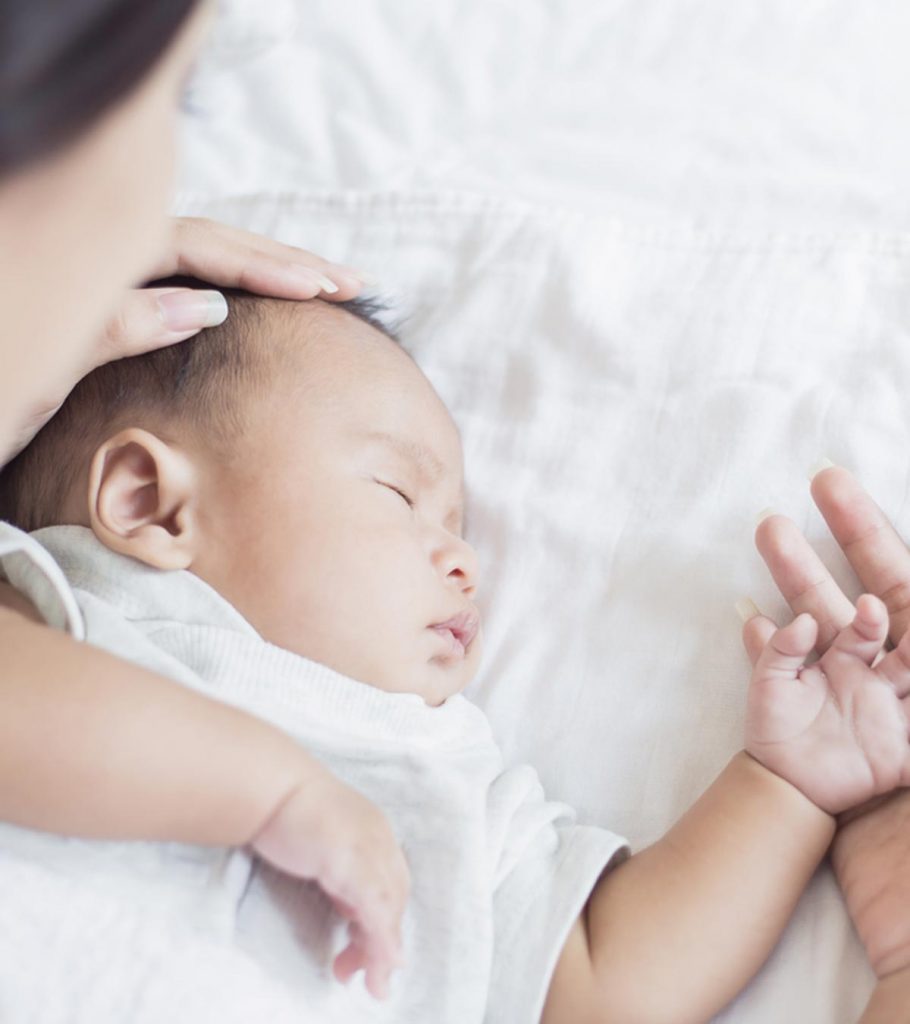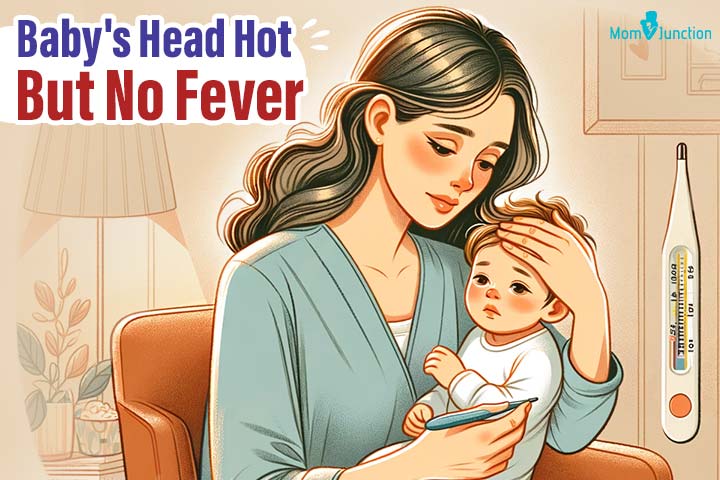There are times when you may notice that the baby’s head is hot, but no fever is present when you check with a thermometer. It is usually a common and seldom a concerning matter. Various external or environmental factors can cause the baby’s head to become hot and make it seem like a fever. The reason is often simple and easy to make out.
Read on to know about the different reasons behind a baby’s head becoming hot without a fever and its management.
Why Is Your Baby’s Head Hot Without A Fever?
Below are some of the conditions and factors that may cause a baby’s head to become hot without the presence of a fever or chills.
- Warm room: If the room is uncomfortably warm, it may lead to discomfort and cause the baby’s head to become hotter than the rest of the body. It could be more commonly a case during hot and humid weather.
According to Po-Chang Hsu, MD, a medical content expert at SleepingOcean.com, “When a baby’s forehead feels hot but the rest of the body seems okay, there’s nothing to worry about. The thermoregulation system in babies isn’t fully developed yet, so such ‘malfunctions’ are normal.”
- Warm clothes:If you dress your baby in clothing inappropriate for the season, the chances are that their head may become hot. Even dressing a baby in a hat or a winter cap during cold weather could make their head warmer than the rest of the body.
- Warm weather: If the weather is warm or you are outdoors under direct sunlight, the baby’s head may stay hot without them having any fever. Being in bright sun for too long might lead to sunstroke or heatstroke, which may irritate the brain’s meninges. It may be why the child’s head feels hot while the rest of the body may seem unaffected.
- Positioning of the head: If the baby happens to lie on their back for too long, such as for nighttime sleep, their head is likely to become hotter without them having any fever.
- Stress and crying:Crying and stress may lead to elevated body temperature due to biochemical changes within the body (1). The rise in temperature could be more evident on the head or forehead. In such cases, the baby would have experienced a stressful situation, such as separation anxiety, causing them to cry.
- Teething: There is a common belief that teething may cause a slight increase in the body temperature, which may be more evident around the face and head However, the available medical evidence suggests that there is no corelation between teething and body temperature (2). You may check for other signs of teething, such as red swollen gums and an urge to bite objects to soothe the irritated gums.
- Physical activity: It is known that any physical activity could lead to a rise in body temperature. Older babies who crawl or walk are likely to have warm-to-touch heads during physical activities.
- Medications: Some medicines may interfere with the thermoregulation processes of the body (3). It may increase overall body temperature or make a specific part of the body, such as the head, hotter.
What To Do If The Baby’s Head Is Hot Without A Fever?
If you notice that the baby’s head is hotter, check their body temperature with a thermometer. Fever in babies is considered when the body temperature is higher than 100.4°F (38°C) (4). If the baby does not have a fever, it indicates their head is hotter than the rest of the body.
Below are a few interventions to consider if your baby’s head feels hot but no fever is present.
1. Dress the baby appropriately
Your baby should be dressed as per the season to prevent them from becoming overheated. Here are some points to keep in mind while dressing the baby (5) (6).
- If the weather is hot or humid, make sure the baby is dressed in a natural, breathable fabric. A temperature higher than 75°F (23°C) is usually considered hot for babies. Avoid layers to prevent overheating. When extremely hot, a diaper and a loose cotton top/shirt may be advisable.
- In a colder climate, dress the child in a bodysuit without a blanket. You may also swaddle them in warm yet breathable fabric. Add or decrease layers according to the temperature to avoid overheating.
Dr. Hsu recommends, “If the room temperature allows for it, one can dress their baby in a sleeveless onesie to prevent further overheating. However, if the room is cool and the baby doesn’t have a fever (meaning only the head is warm but the rest of the body is normal), parents can opt for a breathable sleeping sack or a cotton onesie with long sleeves.”
- Use a breathable cotton crib mattress to allow ventilation and prevent the head from overheating. You may also prefer a crib with guard rails that allow adequate air circulation.
2. Check the room temperature
The room temperature could also influence the temperature of your baby’s head. Keep the following points in mind about room temperature for babies (7).
- Maintain a room temperature of 65 to 70°F (18 to 21°C) in all seasons. A baby may be unable to adjust and adapt to changes in ambient temperature, making it imperative to maintain a stable temperature range.
- During summers, you may use air conditioners to maintain room temperature, while room heaters are useful during winters.
- Ensure there is adequate ventilation in the room during summer if you do not intend to use an air conditioner. Place a wet cloth on an open window to cool the incoming breeze.
- Use a ceiling fan to circulate the air. You may also use a table fan, but do not point it directly at the baby and place it beyond the baby’s reach.
3. Check conditions that alter body temperature
Several miscellaneous situations or conditions could make the baby’s head hot without fever. Here is how you may deal with them.
- Change the timings for outdoor activity during warm weather. Prefer taking the baby in the morning or late in the evening to protect them from excess heat.
- Keep your baby hydrated with frequent breastfeeding sessions during hot weather. It can prevent dehydration, which may also cause a baby’s head and body to become hot to touch.
- Provide teethers to teething babies to subdue the irritation caused by inflamed gums. Pick a one-piece teether that will not break and ensure it is made from non-toxic materials.
- Check and address the various causes of stress and crying in babies. For instance, if the baby cries and becomes clingy due to separation anxiety, work on methods that can help the baby grow habituated to staying away from parents for some time. You may take the help of an expert or a support group or formulate your own ways based on your observations.
Nevertheless, if you feel that your baby is unwell or there are some other unusual signs or symptoms, it is advised to see a doctor for a thorough medical evaluation.
When To See A Doctor?
Consult a doctor in the following scenarios.
- The baby’s head continues to stay hot over several days despite interventions, such as changes in clothing and improvement in room ventilation.
- The baby is younger than three months.
- The baby’s head became hotter after a dose of medication.
- You notice possible signs of infection, such as vomiting, nausea, dizziness, and diarrhea.
- The baby also shows other issues, such as reduced appetite and poor sleep.
- You notice possible signs of gum infection, such as gum bleeding, in the teething baby.
- The little one seems to display signs of dehydration, such as fewer soiled diapers, dark urine, lack of tears while crying, dry skin and mouth, and lethargy.
It is common to find your baby’s head hot but no fever. This condition is mostly harmless and may occur due to a warm room, warm clothes, crying, or physical activity. If your baby’s head feels hot, check their body temperature with a thermometer. If they do not have a fever, check its possible causes. The condition may have occurred due to inappropriate clothes or warm room temperature. Changing these conditions may bring the head’s temperature back to normal. However, talk to your doctor if your baby is less than three months old, shows signs of infections, or is dehydrated.
Key Pointers
- Warm clothing, increased room temperature, hot climate, or screaming can also cause a baby’s head to become hot even without feverish symptoms.
- Certain medications can cause an increase in body temperature by interfering with thermoregulation processes.
- Dressing the baby according to the weather and monitoring the room temperature can help avoid increasing temperature in babies.
Worried about why your baby’s head is hot but their body is cold? Find out why in this helpful video!











